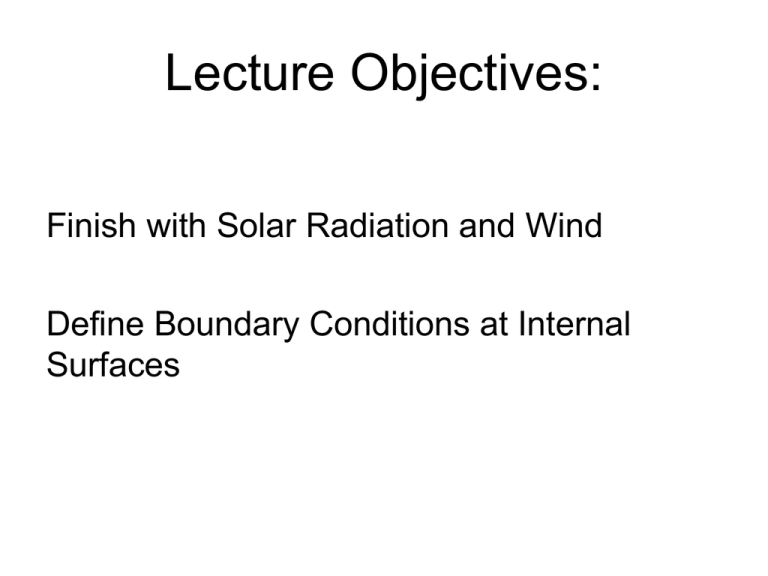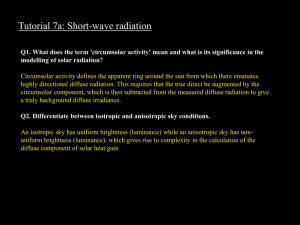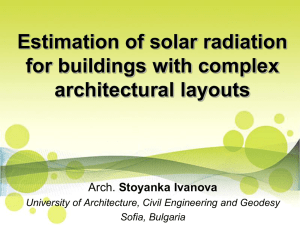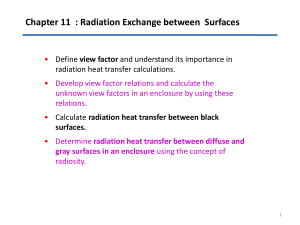Internal Boundary Conditions
advertisement

Lecture Objectives:
Finish with Solar Radiation and Wind
Define Boundary Conditions at Internal
Surfaces
Solar radiation
• Direct
• Diffuse
• Reflected (diffuse)
Direct Normal
radiation
External
surface
n
Reflected
Sky Diffuse
Solar Angles
Sun beam
z
W
Vertical
surface
S
S
N
No rmal to vertical
surface
E
- Solar azimuth angle
– Angle of incidence
Direct and Diffuse Components of
Solar Radiation
Ho rizontal shading
b ea
m
Asha ded
Wind ow
External wall
Aun shad ed
Vertical shading
Vertical shading
Sol
ar
Measurement of Direct Solar
Radiation
Global horizontal radiation IGHR
and Diffuse horizontal radiation
measurements
I DifusseHoi zontalRadiation (IGHR I DNR cos )
HW1 Problem
2.5 m
8m
8m
Internal
surfaces
You will need Austin weather data:
http://www.caee.utexas.edu/prof/Novoselac/classes/ARE383/handouts.html
Solar components
• Global horizontal radiation IGHR
• Direct normal radiation IDNR
Direct component of solar radiation on considered surface:
I DIR I DNR cos
Diffuse components of solar radiation on considered surface:
z ) (1 cos ) / 2
I dif _ sky (IGHR I DNR cos
I dif _ reflected I GHR ground (1 cos ) / 2
Total diffuse solar radiation on considered surface:
I dif I dif _ sky I dif _ reflected
External convective heat flux
Presented model is based on experimental data, Ito (1972)
Primarily forced convection (wind):
Velocity at surfaces that are windward:
0.5
u
0.25 U
for U 2 m/s
for U 2 m/s
Velocity at surfaces that are leeward :
U -wind velocity
u 0.3 0.05U
Convection coefficient :
h 3 .5 5 .6 u
Q A h (Tair Tsurface )
u
surface
windward
u
leeward
Boundary Conditions at External
Surfaces
1. External convective heat flux
Required parameters:
N
- wind velocity
- wind direction
- surface orientation
Consequence:
Energy Simulation (ES)
program treats every
surface with different
orientation as separate
object.
leeward
U
windward
Wind Direction
Wind direction is defined in TMY database:
“Value: 0 – 360o Wind direction in degrees at the hou
indicated. ( N = 0 or 360, E = 90, S = 180,W = 270 ). For
calm winds, wind direction equals zero.”
http://rredc.nrel.gov/solar/pubs/tmy2/
http://rredc.nrel.gov/solar/pubs/tmy2/tab3-2.html
U
N
leeward
windward
Wind direction: ~225o
Internal Boundaries
1
C
2
3
Internal sources
Window
2
L
3
3
Transmitted
Solar radiation
A
Convection
1
Room
air node
R
R
ia
ad
3 internal surface node
F
2
2 element-inner node
1 external surface node
ti
on
1
Surface to surface radiation
Exact equations for closed envelope
Qi , j i i , j Ai Ti 4 T j4
i, j 1,2,...,n
Ti
Fi,j - View factors
ψi,j - Radiative heat exchange factor
n
i , j j Fi , j k , j 1 k Fi ,k
k 1
i, j 1,2,...,n
Closed system of equations
Tj
Internal Heat sources
Occupants, Lighting, Equipment
• Typically - Defined by heat flux
– Convective
• Directly affect the air temperature
– Radiative
• Radiative heat flux “distributed” to surrounding surfaces
according to the surface area and emissivity
Qsource {Areai ( i ) / SUM[ Areai ( i i )]} Qsource _ radiation
i
Internal Heat sources
• Lighting systems
– Source of convective and radiative heat flux
– Different complexity for modeling
above structure
qshort_wave
Pl amp
Pla m p
Plala mp
mp
lamp surf ace
A , T su rf
qlong_wave qconvection
qsh or t_w a ve
ql on g_ w av e q co n vectio n
qsh o rt_w ave
q
ql on g_ wav e co n ve ctio n
Surface Balance
For each surface
– external or internal :
All radiation components
Conduction
Convection
Convection + Conduction + Radiation = 0
Air balance - Convection on internal
surfaces + Ventilation + Infiltration
Uniform temperature Assumption
Affect the air temperature
- h, and Q as many as surfaces
- maircp.air DTair= Qconvective+ Qventilation
Tsupply
Qconvective= ΣAihi(TSi-Tair)
Qventilation= Σmicp,i(Tsupply-Tair)
Ts1
mi
Q1
h1
Tair
Q2
h2
Distribution of transmitted solar radiation
DIRECT solar radiation
absorption
r efle
n
ct io
ect
r e fl
ct
re
i
d
n
su
r
ia
ad
t io
n
ion
diffuse reflection
diffuse reflection
fi rst
d
th ir
absorption
n
ct io
e
l
f
re
nd
o
c
se
diffuse reflection
totally absorbed
Floor
SFi A1i A2i A3i ARi
absorption
A1 floor floor
A2 surfaces _ i floor (1 floor ) FF ,i ( i i )
A3 .....
Distribution of transmitted solar radiation
diffuse solar radiation
lighting
ction
window
diffuse emission
diffuse reflection
absorption
s ec o
fle
n d re
diffuse reflection
absorption
diffuse sun
radiation










